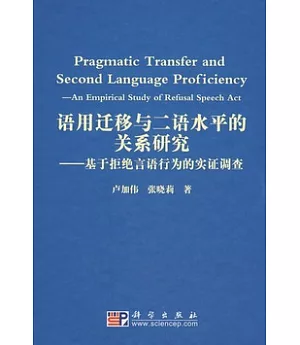語用遷移研究是二語習得領域的一個重要課題。二語水平是影響語用遷移諸多因素中最為明顯的一個,但對語用遷移與二語水平之間關系的研究甚少,且僅有的幾項研究結果對兩者之間的關系爭論較大。本書對語用遷移的類別進行了重新界定,並在對比中美拒絕策略異同的基礎上,通過跟蹤考察一組中國大學生英語學習者拒絕言語行為的發展變化情況來研究二語水平與語用遷移的關系,並提出了一項語用遷移假說,為在大學英語教學中逐漸實施語用教學提供了理論和實踐上的借鑒。
本書適讀于外語及對外漢語專業本科生、研究生,外語教師,語言教學和語言研究教育工作者。
目錄
前言
Acknowledgements
導讀
Chapter 1 Introduction
1.1 Origin of the Research
1.2 Method of the Research
1.3 Organization of the Book
Chapter 2 Literature Review
2.1 Speech Act Theory
2.2 Refusals across Cultures
2.2.1 Rubin﹀s Study
2.2.2 Liao and Bresnahan﹀s Study
2.2.3 Nelson et al.﹀s Study
2.2.4 Wang Aihua﹀s Study
2.3 Concepts of Language Transfer and Pragmatic Transfer
2.3.1 Language Transfer
2.3.2 Pragmatic Transfer
2.4 Major Studies on Pragmatic Transfer in Speech Acts
2.4.1 Studies on Pragmatic Transfer in Other Speech Acts
2.4.2 Studies on Pragmatic Transfer in Refusal Speech Act
2.5 Studies on the Relationship between L2 Proficiency and Pragmatic Transfer
Chapter 3 Research Design and Theoretical Framework
3.1 Research Questions
3.2 Research Methodology
3.2.1 Subjects
3.2.2 Instruments
3.2.3 Data Analysis
3.3 An Operational Criterion for Discussing Pragmatic Transfer
3.3.1 Necessary Evidence for Identifying the Occurrence of Pra~natic Transfer
3.3.2 A Basic Principle for Pragmatic Transfer Identification
3.3.3 Defining the Degree of Discrepancy
3.3.4 Pragmatic Transfer Reclassified
3.4 A Hypothesis on the Relationship between L2 Linguistic Proficiency and L1 Pragmatic Transfer
3.4.1 A Working Criterion to Judge the Relationship between L2 Linguistic Proficiency and L1 Pragmatic Transfer
3.4.2 A Hypothesis on the Relationship between L2 Linguistic Proficiency and L1 Pragmatic Transfer
3.5 Main Theories Employed in Discussing Pragmatic Transfer
3.5.1 Politeness Theory
3.5.2 Gile﹀s Accommodation Theory
3.6 A General Research Procedure of the Study
Chapter 4 Pragmatic Transfer in Chinese EFL Learners﹀ Refusals
4.1 Evidences of Pragmatic Transfer in the Frequency of Semantic Formulas
4.1.1 Evidences of Pragmatic Transfer in the Frequency of Semantic Formulas in Refusals to Requests
4.1.2 Evidences of Pragmatic Transfer in the Frequency of Semantic Formulas in Refusals to Invitations
4.1.3 Evidences of Pragmatic Transfer in the Frequency of Semantic Formulas in Refusals to Suggestions
4.1.4 Evidences of Pragmatic Transfer in the Frequency of Semantic Formulas in Refusals to Offers
4.2 Evidences of Pragmatic Transfer in the Order of Semantic Formulas
4.2.1 Evidences of Pragmatic Transfer in the Order of Semantic Formulas in Refusals to Requests
4.2.2 Evidences of Pragmatic Transfer in the Order of Semantic Formulas in Refusals to Invitations
4.2.3 Evidences of Pragmatic Transfer in the Order of Semantic Formulas in Refusals to Suggestions
4.2.4 Evidences of Pragmatic Transfer in the Order of Semantic Formulas in Refusals to Offers
4.3 Discussions on Pragmatic Transfer in L2 Refusals
4.3.1 Types of Pragmatic Transfer in the Speech Act of Refusal
4.3.2 Influences of Eliciting Factors on Pragmatic Transfer
Chapter 5 The Relationship between L2 Proficiency and L1 Pragmatic Transfer
5.1 The Relationship between Proficiency and Pragmatic Transfer in the Frequency of Semantic Formulas in Each Refusal Eliciting Factor
5.1.1 The Relationship in the Frequency of Semantic Formulas in Refusals to Requests
5.1.2 The Relationship in the Frequency of Semantic Formulas in Refusals to Invitations
5.1.3 The Relationship in the Frequency of Semantic Formulas in Refusals to Suggestions
5.1.4 The Relationship in the Frequency of Semantic Formulas in Refusals to Offers
5.2 The Relationship between Proficiency and Pragmatic Transfer in the Order of Semantic Formulas in Each Refusal Eliciting Factor
5.2.1 The Relationship in the Order of Semantic Formulas in Refusals to Requests
5.2.2 The Relationship in the Order of Semantic Formulas in Refusals to Invitations
5.2.3 The Relationship in the Order of Semantic Formulas in Refusals to Suggestions
5.2.4 The Relationship in the Order of Semantic Formulas in Refusals to Offers
5.3 Discussions on the Relationship between L2 Proficiency and L1 Pragmatic Transfer in the Refusal Speech Act
5.3.1 The Influence of Eliciting Factors on the Relationship between L2 Proficiency and L1 Pragmatic Transfer
5.3.2 Other Factors Affecting the Relationship between Linguistic Proficiency and Pragmatic Transfer
5.3.3 Hypothesis Testing: the Relationship between L2 Proficiency and L1 Pragmatic Transfer
5.3.4 The Acquisition Expectation for the Relationship between L2 Proficiency and L1 Pragmatic Transfer: Positive or Negative?
Chapter 6 Causal Factors for Pragmatic Transfer and Reassessment of Its Role in SLA
6.1 Causal Factors for Pragmatic Transfer
6.1.1 Learner-external Factors for Pragmatic Transfer
6.1.2 Learner-internal Factors for Pragmatic Transfer
6.2 Reassessment of the Role of Pragmatic Transfer in SLA
Chapter 7 Major Findings and Prospects for Future Studies
7.1 Major Findings of the Present Study
7.2 Significance of the Research
7.3 Prospects for Future Studies on Pragmatic Transfer
Bibliography
Appendix I Discourse Completion Test
Appendix II Discourse Completion Test [Chinese Version]
Appendix III Classification of Refusals [Beebe et al. (1990)]
Appendix IV Classification of Refusals (Revised Version for This Book)
Acknowledgements
導讀
Chapter 1 Introduction
1.1 Origin of the Research
1.2 Method of the Research
1.3 Organization of the Book
Chapter 2 Literature Review
2.1 Speech Act Theory
2.2 Refusals across Cultures
2.2.1 Rubin﹀s Study
2.2.2 Liao and Bresnahan﹀s Study
2.2.3 Nelson et al.﹀s Study
2.2.4 Wang Aihua﹀s Study
2.3 Concepts of Language Transfer and Pragmatic Transfer
2.3.1 Language Transfer
2.3.2 Pragmatic Transfer
2.4 Major Studies on Pragmatic Transfer in Speech Acts
2.4.1 Studies on Pragmatic Transfer in Other Speech Acts
2.4.2 Studies on Pragmatic Transfer in Refusal Speech Act
2.5 Studies on the Relationship between L2 Proficiency and Pragmatic Transfer
Chapter 3 Research Design and Theoretical Framework
3.1 Research Questions
3.2 Research Methodology
3.2.1 Subjects
3.2.2 Instruments
3.2.3 Data Analysis
3.3 An Operational Criterion for Discussing Pragmatic Transfer
3.3.1 Necessary Evidence for Identifying the Occurrence of Pra~natic Transfer
3.3.2 A Basic Principle for Pragmatic Transfer Identification
3.3.3 Defining the Degree of Discrepancy
3.3.4 Pragmatic Transfer Reclassified
3.4 A Hypothesis on the Relationship between L2 Linguistic Proficiency and L1 Pragmatic Transfer
3.4.1 A Working Criterion to Judge the Relationship between L2 Linguistic Proficiency and L1 Pragmatic Transfer
3.4.2 A Hypothesis on the Relationship between L2 Linguistic Proficiency and L1 Pragmatic Transfer
3.5 Main Theories Employed in Discussing Pragmatic Transfer
3.5.1 Politeness Theory
3.5.2 Gile﹀s Accommodation Theory
3.6 A General Research Procedure of the Study
Chapter 4 Pragmatic Transfer in Chinese EFL Learners﹀ Refusals
4.1 Evidences of Pragmatic Transfer in the Frequency of Semantic Formulas
4.1.1 Evidences of Pragmatic Transfer in the Frequency of Semantic Formulas in Refusals to Requests
4.1.2 Evidences of Pragmatic Transfer in the Frequency of Semantic Formulas in Refusals to Invitations
4.1.3 Evidences of Pragmatic Transfer in the Frequency of Semantic Formulas in Refusals to Suggestions
4.1.4 Evidences of Pragmatic Transfer in the Frequency of Semantic Formulas in Refusals to Offers
4.2 Evidences of Pragmatic Transfer in the Order of Semantic Formulas
4.2.1 Evidences of Pragmatic Transfer in the Order of Semantic Formulas in Refusals to Requests
4.2.2 Evidences of Pragmatic Transfer in the Order of Semantic Formulas in Refusals to Invitations
4.2.3 Evidences of Pragmatic Transfer in the Order of Semantic Formulas in Refusals to Suggestions
4.2.4 Evidences of Pragmatic Transfer in the Order of Semantic Formulas in Refusals to Offers
4.3 Discussions on Pragmatic Transfer in L2 Refusals
4.3.1 Types of Pragmatic Transfer in the Speech Act of Refusal
4.3.2 Influences of Eliciting Factors on Pragmatic Transfer
Chapter 5 The Relationship between L2 Proficiency and L1 Pragmatic Transfer
5.1 The Relationship between Proficiency and Pragmatic Transfer in the Frequency of Semantic Formulas in Each Refusal Eliciting Factor
5.1.1 The Relationship in the Frequency of Semantic Formulas in Refusals to Requests
5.1.2 The Relationship in the Frequency of Semantic Formulas in Refusals to Invitations
5.1.3 The Relationship in the Frequency of Semantic Formulas in Refusals to Suggestions
5.1.4 The Relationship in the Frequency of Semantic Formulas in Refusals to Offers
5.2 The Relationship between Proficiency and Pragmatic Transfer in the Order of Semantic Formulas in Each Refusal Eliciting Factor
5.2.1 The Relationship in the Order of Semantic Formulas in Refusals to Requests
5.2.2 The Relationship in the Order of Semantic Formulas in Refusals to Invitations
5.2.3 The Relationship in the Order of Semantic Formulas in Refusals to Suggestions
5.2.4 The Relationship in the Order of Semantic Formulas in Refusals to Offers
5.3 Discussions on the Relationship between L2 Proficiency and L1 Pragmatic Transfer in the Refusal Speech Act
5.3.1 The Influence of Eliciting Factors on the Relationship between L2 Proficiency and L1 Pragmatic Transfer
5.3.2 Other Factors Affecting the Relationship between Linguistic Proficiency and Pragmatic Transfer
5.3.3 Hypothesis Testing: the Relationship between L2 Proficiency and L1 Pragmatic Transfer
5.3.4 The Acquisition Expectation for the Relationship between L2 Proficiency and L1 Pragmatic Transfer: Positive or Negative?
Chapter 6 Causal Factors for Pragmatic Transfer and Reassessment of Its Role in SLA
6.1 Causal Factors for Pragmatic Transfer
6.1.1 Learner-external Factors for Pragmatic Transfer
6.1.2 Learner-internal Factors for Pragmatic Transfer
6.2 Reassessment of the Role of Pragmatic Transfer in SLA
Chapter 7 Major Findings and Prospects for Future Studies
7.1 Major Findings of the Present Study
7.2 Significance of the Research
7.3 Prospects for Future Studies on Pragmatic Transfer
Bibliography
Appendix I Discourse Completion Test
Appendix II Discourse Completion Test [Chinese Version]
Appendix III Classification of Refusals [Beebe et al. (1990)]
Appendix IV Classification of Refusals (Revised Version for This Book)
網路書店
類別
折扣
價格
-
新書3折$63




























